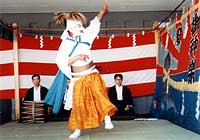
| Pseudonym reading | My school |
|---|---|
| Specified type | Prefecture designation |
| Type | Intangible folk cultural property |
| Designated date | May 11, 2001 |
| Specified details | |
| quantity | |
| location | Kitakami City Waka-machi Agariko Kitakami City Murasakino Futako Town in Kitakami City Hanamaki City Kitakanma |
| owner | |
| Holding group | Waga Daikori Kagura Preservation Society Murasakino Daikori Kagura Preservation Society Yado Ohkori Kagura On-line at Oyado Waka Orikori Kagura |
| Management organization | |
| home page | Ozonari Kagura (Kagura and our lives) Waga Oonori Kagura (Gyeongchang Temple) |
Overview
Between Kitakami city in the former Waka-gun and Hanamaki-shi, Kagura, which is generally called "Narikon Kagura", is popular.
It is one of the gyoza kagura that has been handed down by the Shugen Yamabushi, and it has been classified as Yamabushi Kagura, but it is a prayer with a darker prayer than Yamabushi Kagura. It is considered as a system.
The main feature of the Ozonari Kagura is that the curse of the study is properly performed by hand choreography, closing and stepping.
Originally the stage decoration was strict, and we made bamboo bamboo at the four corners of the stage, held the Tenjingu shrine on one side, set up a pillar at the corner between Onimon (Tohoku) and back gate (southwest), erected a pillar and stretched thick Shimenawa. It is said.
There are 33 kinds of works, and based on the Honji epic theory, Honchi Buddha is told.
The history of the old Waka region's history of the Samurai Kagura goes back to the end of the Middle Ages in the tradition of the great-grandson's Waga-Ohori Kagura, but recordly from the end of the Edo period to the beginning of the Meiji era It is clear that the Kagura was being held, and a joint meeting was held at Kacho 2 in 1849 and in 1875 in 1875 at the Self Sex Center (Kamie Shijoe, Kitakami city). .
Currently, Waga Taiko Kagura (Kagokami City Waga Town great grandson), designated as a prefecture designated cultural property in 1949, who is playing the Kaikoku screen in the former Waga-gun, is designated as a prefecture designated cultural property in 1979, The city is Murasakino), the lodgings are Daikori Kagura (Fujiko Town in the same city), the Oyado Waga Kagura (Fujiko Town in the same city), and the Kasama Tairikoraku Kagura (Hokkaido, Hanamaki City).
With the exception of Waga Oonori Kagura, they all follow the flow of Zen-ho-in and the curse of learning is properly inherited.
As described above, "Waga no Odori Kagura" represented by Waga Daikori Kagura, Murasakino Daikori Kagura, lodging Daikori Kagura, Oyado Waka Kagura, and Kasama Daikori Kagura, while inheriting the characteristics of the Saiko Kagura, regional features It shows well.
(Intangible Folk Cultural Property Designation Criteria 2- (3))
image

